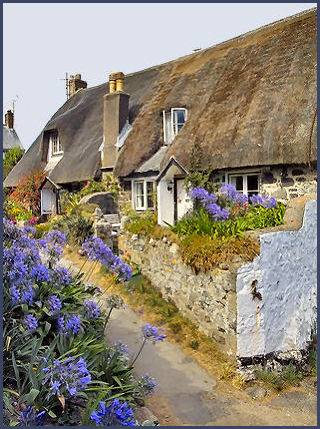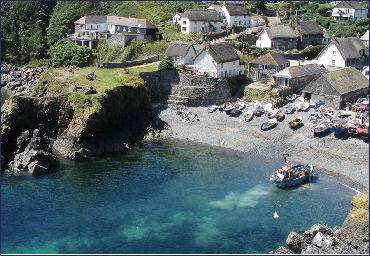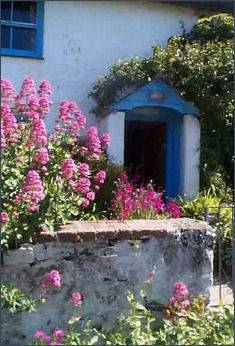Cadgwith
OS Grid ref:- SW7214
 Cadgwith, known in the Cornish language as 'Porthkaswydh', lies on the eastern side of the Lizard Peninsula between the Lizard Point and the village of Coverack, Cadgwith is a highly picturesque village which time seems to have passed by.
Cadgwith, known in the Cornish language as 'Porthkaswydh', lies on the eastern side of the Lizard Peninsula between the Lizard Point and the village of Coverack, Cadgwith is a highly picturesque village which time seems to have passed by.
 A small brook runs through the cove over the sand and shingle beach and into the sea. On either side of the gushing brook, characterful old cottages built of the local rock, serpentine, many roofed with thatch, (which is fairly rare throughout Cornwall as slate has been in use for many years) cling to the sides of scenic Cadgwith Cove.
A small brook runs through the cove over the sand and shingle beach and into the sea. On either side of the gushing brook, characterful old cottages built of the local rock, serpentine, many roofed with thatch, (which is fairly rare throughout Cornwall as slate has been in use for many years) cling to the sides of scenic Cadgwith Cove.
Serpentine, found in abundance in the area, is a dark green metamorphic rock, with red and white veins.
Known in Cornish as Porthkajwydh, meaning cove of the thicket, the village has its origins in medieval times as a collection of fish cellars. From the sixteenth century, Cadgwith came to be inhabited, with fishing as the main occupation. Subsequently houses, lofts, capstan houses, and cellars constructed of local stone or cob walls and thatched or slated roofs were built along the beach and up the sides of the valley. The village huddles beneath steep cliffs, is divided into two beaches by a promontary known as the Todden. The larger beach to the north east is composed mainly of shingle, the smaller beach to the south west is mainly sand and boulders. The large cliff to the south of the cove is known as the Man o' War.
 Fishing boats, along with a plethora of lobster pots, lie on the pebbled beach and on the beams of the nearby loft, tallies of the pilchard catches can still be viewed by the visitor, as can the old pilchard cellar.
Fishing boats, along with a plethora of lobster pots, lie on the pebbled beach and on the beams of the nearby loft, tallies of the pilchard catches can still be viewed by the visitor, as can the old pilchard cellar.
The village was a major fishing harbour in past centuries, holding the record for pilchards with 1.3 million caught in a single day in the nineteenth century. The cove is still home to a small fleet of crabbing boats which are winched up the shingle beach. These days the main catch is not pilchards but crab, lobster, mackerel, monkfish, shark and mullet.
 Cadgwith's characterful main street winds its way up the hillside. The tiny village church, which is made of corrugated iron, is open to the public and contains a brief history of Cadgwith, a visitors book and offers postcards for sale.
Cadgwith's characterful main street winds its way up the hillside. The tiny village church, which is made of corrugated iron, is open to the public and contains a brief history of Cadgwith, a visitors book and offers postcards for sale.
The local pub, the Cadgwith Cove Inn, which is over three hundred years old, is reknowned for it's singing of Cornish songs of a Friday evening. Next door stands The Old Cellars restaurant, which once operated as one of Cadgwith's pilchard cellars, where the fish would have been pressed and salted. The Watch House, a small black-painted hut, overlooking the cove, was probably the customs look-out. There are also cafes and art galleries to see and a shop selling delicious Cornish ice cream.
The Devil's Frying Pan, a collapsed cave with a remaining arch of a rock, is a spectacular coast feature and is some two hundred feet deep. Waves crash into a now roofless atmospheric cavern, is just a short walk southwards along the coastal path which follows the panoramic cliffs. The site is owned by the National Trust.
The coastline of the Lizard Peninsula is notoriously treacherous, mainly due to a combination of submerged rocks and weather factors, gales, storms, or fog. There are numerous wrecks on the rocks off Lizard Point known as The Stags, and The Manacles which lie near Coverack, and there are a number of other rocks off the coast of Cadgwith known as The Craggan and The Boa. Deep sea diving onto the wrecks is quite popular.
Visitor Attractions on the Lizard Peninsula
National Seal Sanctuary at Gweek, founded in 1958 and devoted to seal rescue and care, baby seals are in the sanctuary from September - March. Open daily, except Christmas Day, from 10a.m..
Lizard LighthouseThe Lizard Lighthouse is open to the public, a visitor car park is provided by the entrance gate. Visitors may ascend the 70 metre high lighthouse tower from where there are stunning views. The coastline around the lighthouse offers spectacular walks along the cliffs. Open July 11.00 - 18.00, August 11.00-19.00
*Lizard Countryside Centre fully interactive exhibition based on local countryside, history and wildlife. Open Easter - Oct, daily, 11am - 5pm.
Bonython Manor The superb garden at Bonython covers 20 acres and its plantations of Montrerey pine and beech trees were planted in the 1830s. There is much for the gardening enthusiast to see at Bonython. Open April - October, Tuesday, Wednesday, Thursday and Friday, 10.00am - 4.30pm
*Trelowarren House and Craft Centre Magwan-in-Meneage, Elizabethan style Stuart building with a Victorian interior, home to the Vyvyan family, hosts crafts exhibition. Open all year.
*Marconi Memorial , Poldhu, art deco obelisk just south of Poldhu Bay, first radio signals across Atlantic were sent from here by Guglielmo Marconi.
*Goonhilly Earth Station, futuristic satellite tracking station built in 1962, visitor centre with interactive displays and hands on exhibitions, tours of the site. Open, Easter - Oct, 10am - 5pm (6pm in high season).